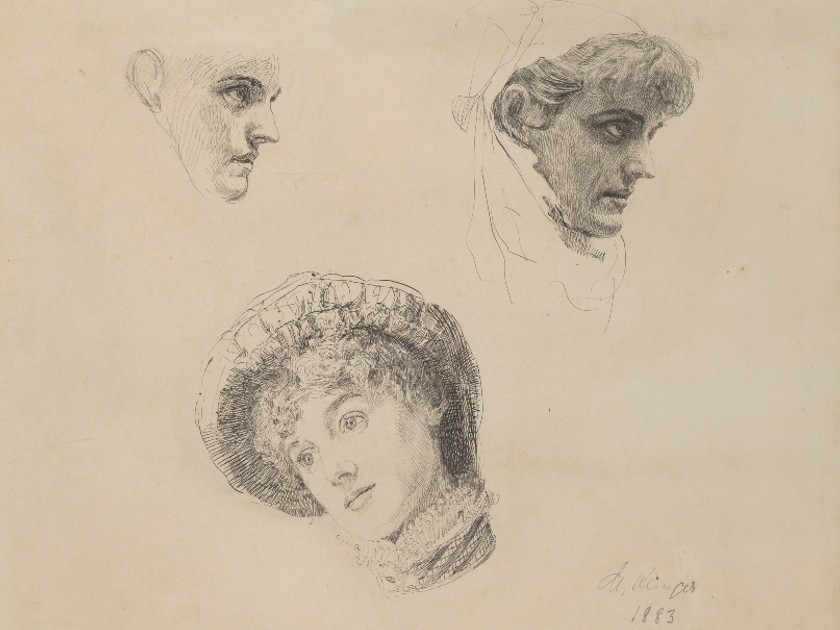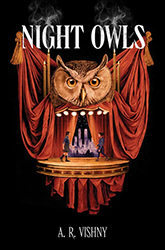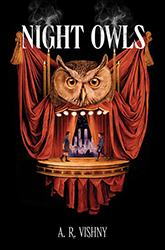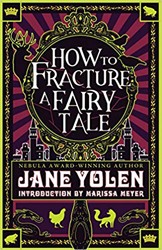
Three Studies of Heads of Women, Max Klinger, 1883
Gift of Alexander B.V. Johnson and Roberta J.M. Olson, 2012, The Metropolitan Museum of Art
Okay, but what’s an estrie?
It’s the single most common question I get, whenever I mention they’re the subject of my debut novel, Night Owls.
The short answer is that they are Judaism’s vampires: women who appear as ordinary members of the community, but feed on the blood of unwitting men. They can shapeshift; and they can fly when their hair is let down; they are healed by bread and salt; the recommended way to kill one is to bury her. The folklore and imagery surrounding them has some overlap with that of Lilith. Most of the lore is traced to Sefer Hasidim, a medieval text chronicling Jewish life and practices in twelfth and thirteenth century Germany.
But usually, when people ask me that question, that’s not really the answer they’re looking for. Or even the heart of the matter. The real question they’re asking is, Why haven’t I heard of this Jewish vampire lady thing? Because most Jews I know, including learned, actively-engaged community leaders, have never heard of estries. I have a lifetime of robust Jewish education under my belt, and only heard of them in a talk given by author Rena Rossner about magic and monsters in Jewish folklore at a 2019 Jewish writers’ symposium.
So, why haven’t you heard of this Jewish vampire lady thing? The answer reasonably encompasses Maimonides, the Haskalah, the trajectory of Jewish emancipation in Europe, and assimilationist aspirations among other factors. All of these schools of thought and historical events prioritized rational expressions of Judaism over the fantastic. More than that though is the long history of systematic violence against European Jewish civilization and the devastation of the Holocaust. Estries are obscure for the same reason that almost every Jewish magical creature, save perhaps the golem, is considered “obscure” — we’re a tiny people whose culture our enemies have long sought to destroy. And for the most part, these magical creatures are just not something that figure prominently in the way most of us participate in Jewish life today.
This is not the case in the world of Jewish genre fiction. In the last ten years, there have been lots of exciting new works of Jewish fantasy in both the children’s and adult space that have featured dybbuks, shedim, mazzikin, and of course, golems. Night Owls is not the first, or the second, or even the third children’s book in the last few years to feature an appearance from Ashmodai (the King of the shedim), which I find frankly incredible. But this also means that the Jewish cultural elements that have most excited Jewish fantasy and speculative fiction also happen to be things that can feel somewhat removed from day-to-day Jewish life as we typically experience it. Bird-footed demons and flying vampire women are objectively super cool, but I’m not going to pretend that they ever came up in my very ordinary Hebrew school curriculum growing up.
The narrative voice at times blurs the line between the real and fable in the way that we often do when describing the feats of our ancestors that have achieved a mythic status in a family’s collective memory.
From an author’s perspective, obscurity is exciting. There’s a thrill that comes with writing in less trodden territory. But it can be an intimidating puzzle for a Jewish writer chasing authenticity. Authenticity requires something to be more than technically accurate. Authenticity requires that it feel true to readers, that it reads as though it’s coming from a place of actual, lived knowledge. And the moment magical creatures enter the mix, that can become a very difficult needle to thread.
Therefore in order for my story to work and the Judaism on the page to have this sense of authenticity for the reader, I needed the presence of estries to feel like a natural extension of a recognizable Jewish world. That required grounding the narrative in a setting that felt lived in and the kinds of characters that populate my life — American Jews, Israelis, and Israeli Americans who are restless dreamers and fiercely devoted to their loved ones. I ultimately turned to the folklore that did feel familiar, and was present in my Jewish upbringing: the stories of real women whose feats of strength and courage would seem to be the stuff of legend. The women in my family’s lore were not shape-shifting vampires, but they crossed the Atlantic on their own to track down the husband who abandoned her in Europe, and pursued degrees when such things were rare. They had uncanny intuitions to make romantic matches or see the dead. They not only survived war, hardship, illness, and persecution, but saved their husbands and their children, too. I gave each of my estries a background intended not only to establish their character arc but also to solidify the place of estrie lore in our world. The narrative voice at times blurs the line between the real and fable in the way that we often do when describing the feats of our ancestors that have achieved a mythic status in a family’s collective memory.
Night Owls brings estries from medieval texts into the foreground of Jewish experience. My estries have fought hard for a tenuous place in a world inclined to despise and erase them. They are hungry. So great are their ambitions and desires that they would seem a supernatural power, one that has given them wings. Estries are not an obscure aside, but rather a familiar fixture of Jewish history, the Jewish women who stop at nothing to ensure they, and their loved ones, survive.

Night Owls by A. R. Vishny



